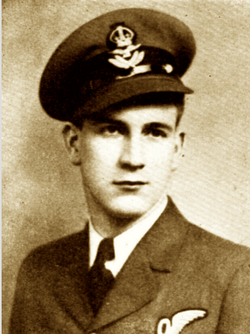


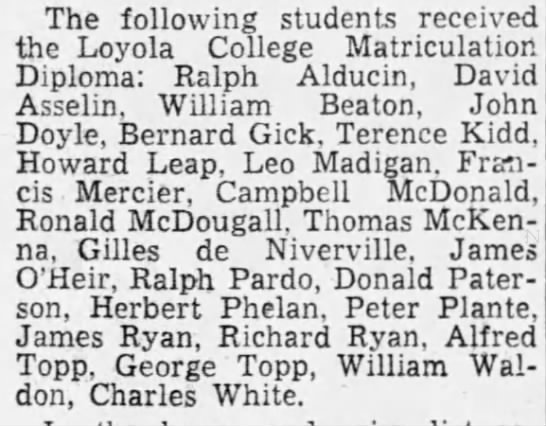
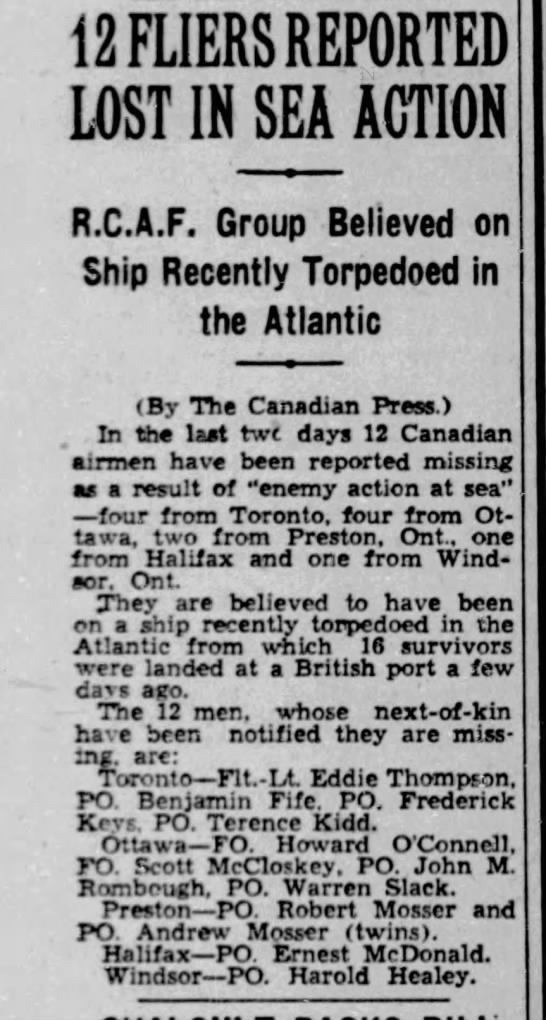
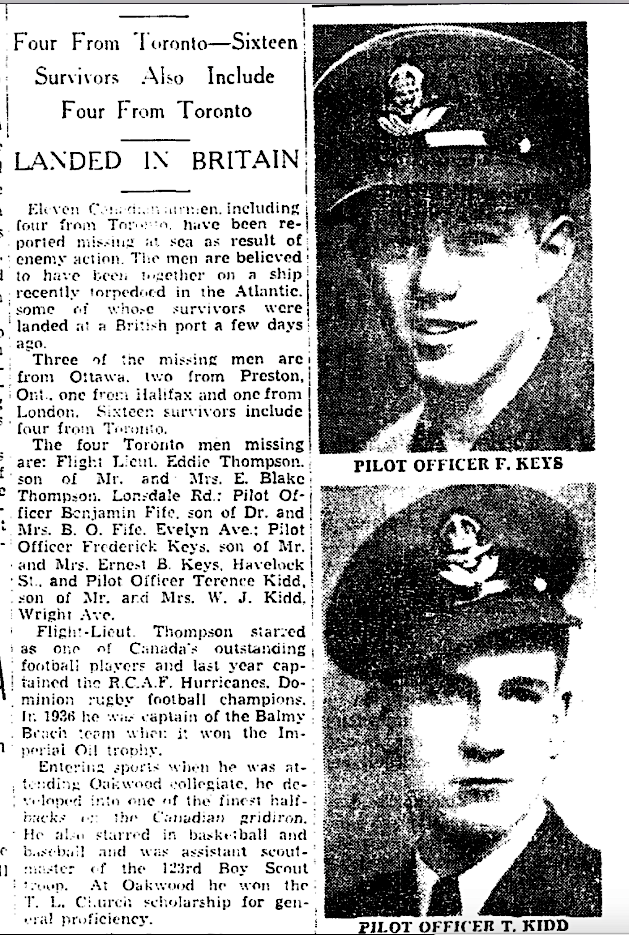
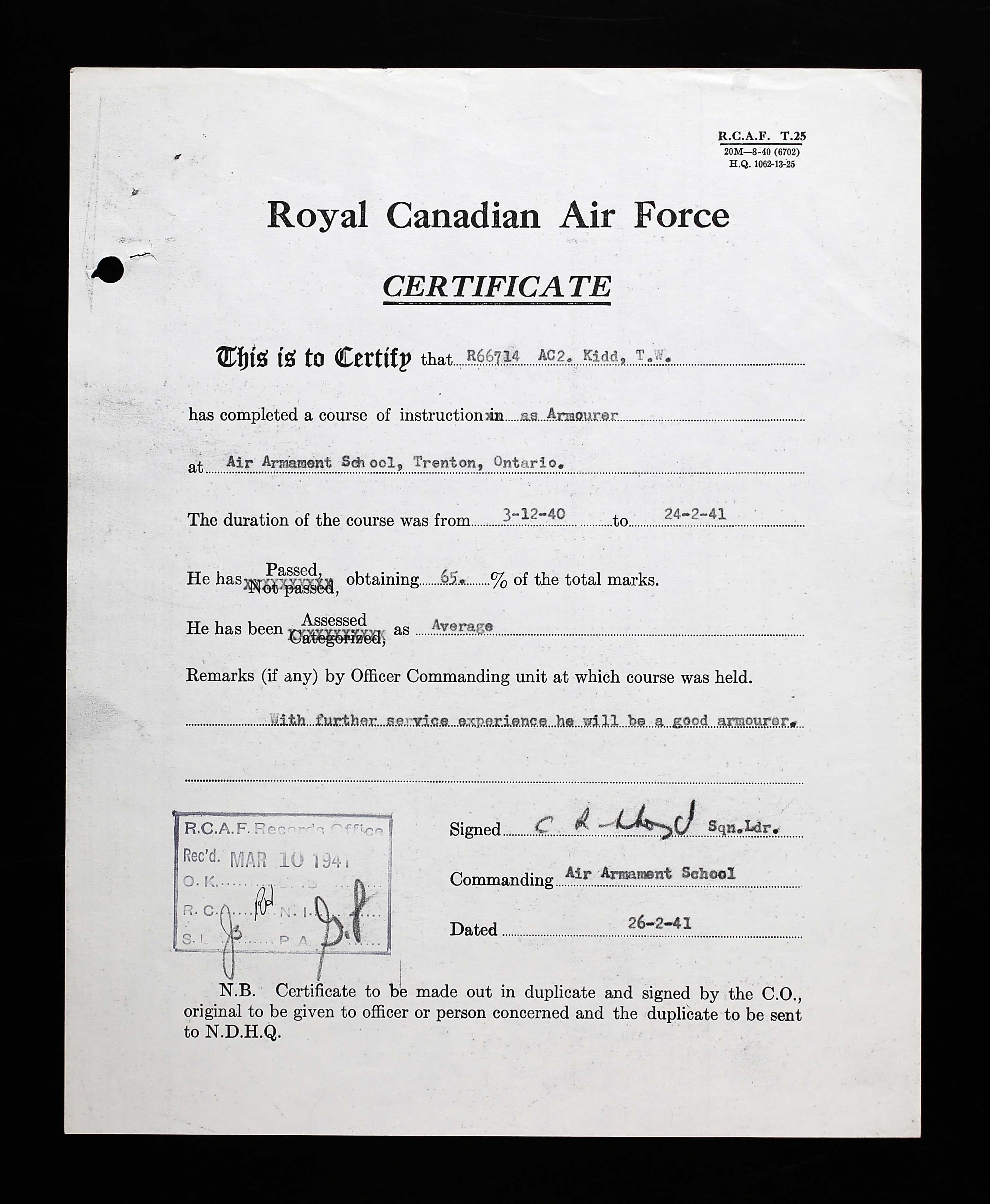
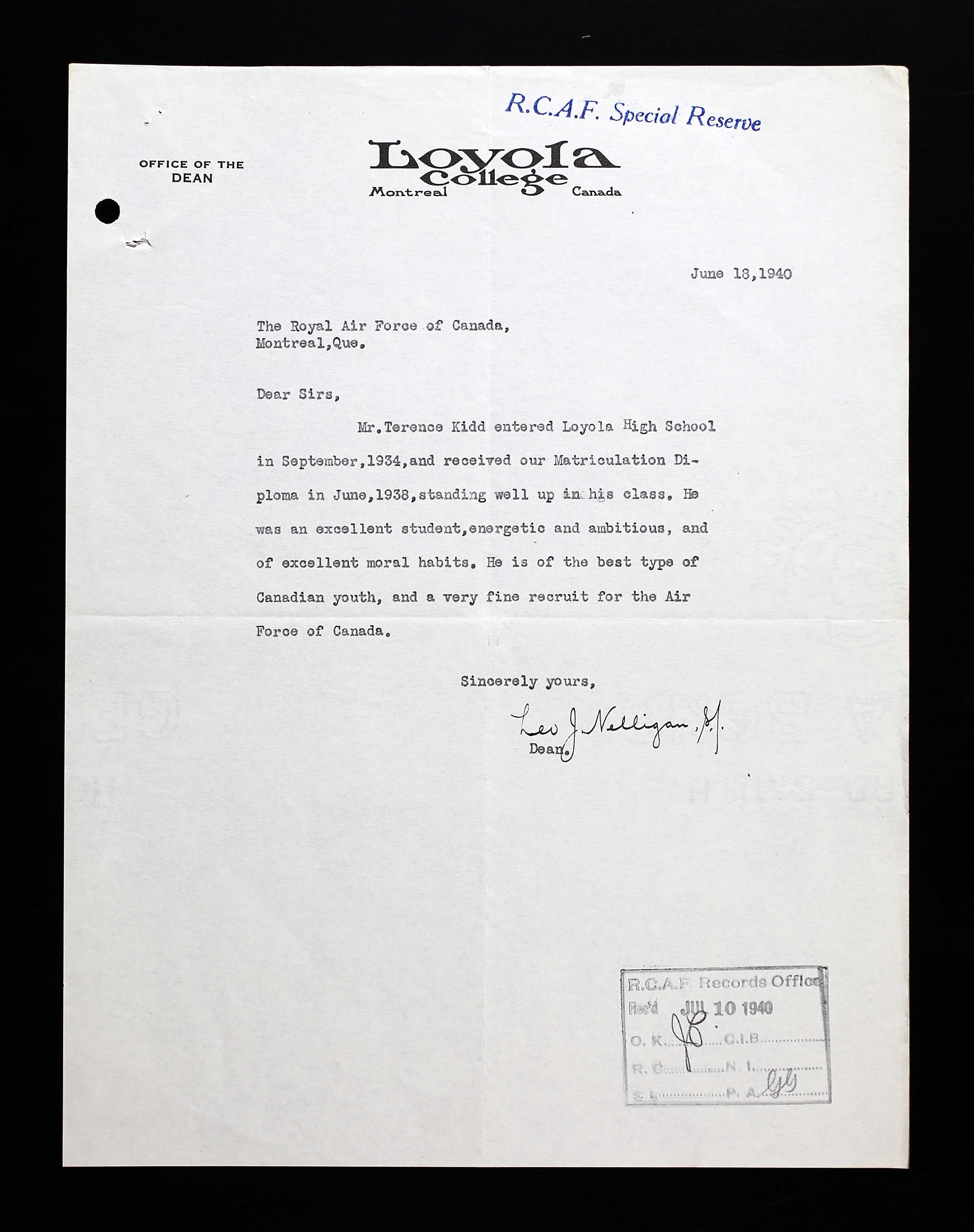
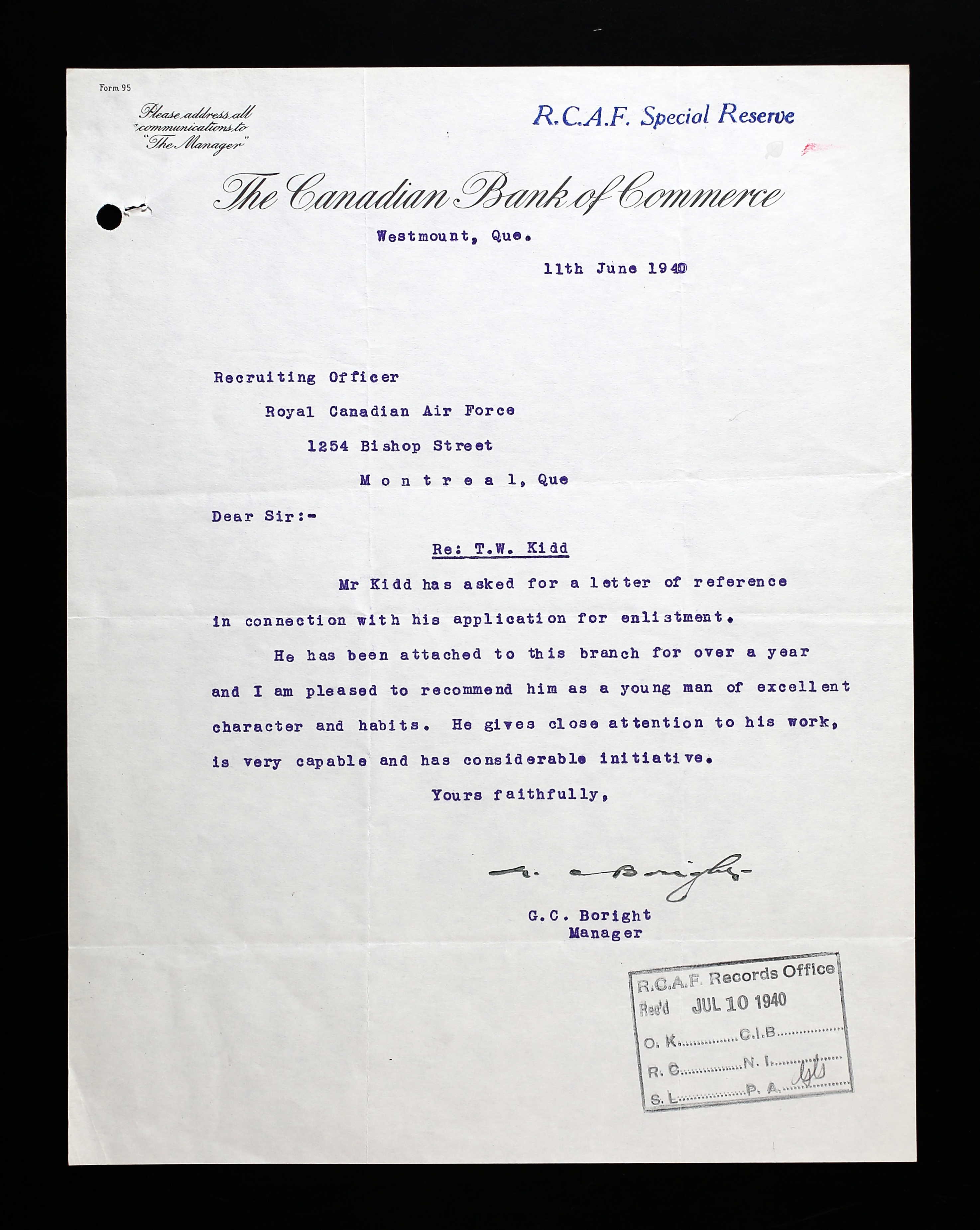
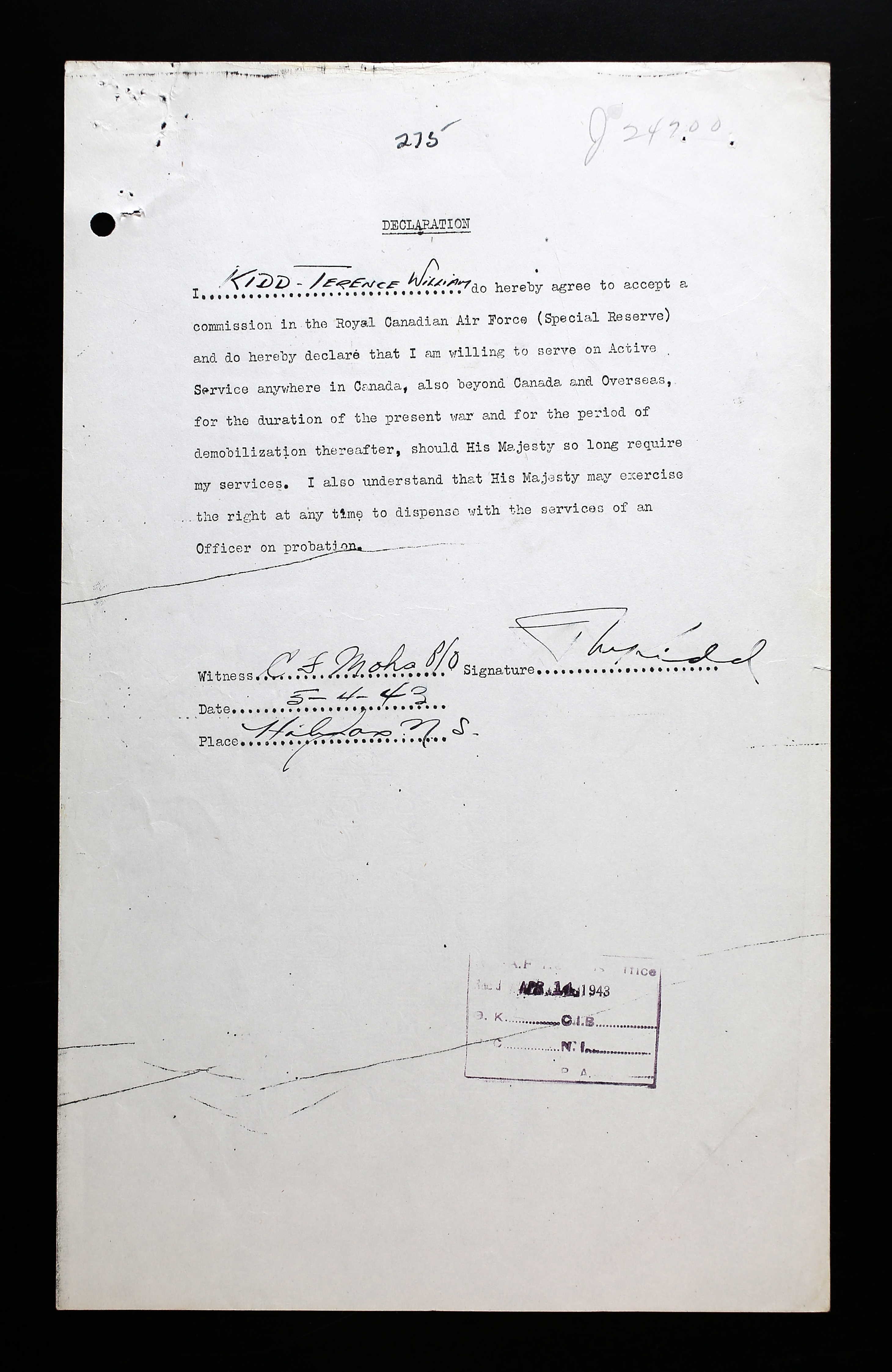
September 30, 1919 - April 22, 1943










Terence William Kidd was the son of Mabel Augusta (nee Barnhart) Kidd (1888-1954) and her husband, Aeneas Joseph Kidd (1887-1952), of 276 Wright Avenue, Toronto, Ontario. Mr. Kidd was the assistant to the signal engineer with Canadian Pacific Railway. He had two brothers: Aeneas Joseph, Jr (who later became Father Kevin Kidd), and William Edward, and two sisters: Grace Catherine Nora and Shirley Christine. The family was Roman Catholic.
The Kidd family had lived in Montréal, Quebec, where Terence was born and received his education, graduating from Loyola College in 1938. He did very well in English, earning honours. While at college, he had two years of COTC.
Terry was a ledgerkeeper at the Canadian Bank of Commerce in Westmount, Quebec from 1938 until his enlistment in June 1940. He indicated he was $35 in debt to the bank but “it would be taken care of upon enlistment.” He requested ground duties as an armourer with the RCAF. He was accepted into the RCAF in Montreal, July 3, 1940. After the war, he wanted to pursue aeronautical engineering.
He liked skiing extensively, hockey moderately, softball, tennis, and golf occasionally, as well as liked to swim. He spoke both English and French.
Terry stood 5’8” tall, weighed 141 pounds, had a fair complexion, hazel eyes and fair hair. He had a beer almost daily, and smoked 11-12 cigarettes per day. He had had the measles and Scarlet Fever as a child.
Terry was sent to No. 2 Manning Depot, Brandon, Manitoba July 3 until November 24, 1940. From there he was at No. 1 Manning Depot, Toronto for a week before being sent to Trenton where he attended the Air Armament School from December 3, 1940 to February 24, 1941, completing his course with a 65%. “With further experience, he will be a good armourer.”
He was sent to No. 4 Bomb and Gunnery School, Fingal, Ontario from February 26 to November 13, 1941.
Then Terry found himself at No. 1 Air Observer School, Malton, Ontario until April 11, 1942. He was an armourer (bombs).
When Terry requested to be remustered to a pilot in the spring of 1942, the interviewing officer F/O N. J. Moran commented, “Medium build, neat, clean cut appearance in uniform, pleasant personality. Confident, sincere, organized, athletic. Good family background, first made application for P & O, but accepted Armourer’s course to enlist in RCAF. Appears to have courage, stability, and other qualifications for good Aircrew material. Good record to date in RCAF.”
Other evaluations: “Alert, quick, responsible lad of average intelligence, good initiative and aggressiveness. Emotional stability better than average.” F/L C. G. Stogdill. “Wants 1. Pilot 2. Observer 3. Air Gunner. Junior matriculation at 18, bank clerk 3 years. Some previous interest in flying and some mechanical aptitude. Average athlete, average intelligence. Keen, confident, alert, stable and mature.” F/L W. K. Kerr. “Above average.”
No. 1 ITS, Toronto, April 12 to July 18, 1942: “A quiet, steady serious minded airman. Neat in appearance and a good worker who has shown fine service spirit. Second aircrew recommendation: Air Observer.” 82% in maths, 55.5% in navigation.
No. 12 EFTS, Goderich, Ontario July 19 to September 12, 1942: “Pleasant, hard working boy, a good average student. Link mark: 58.”
No. 16 SFTS, Hagersville, Ontario, September 13 to October 24, 1942: ‘Flying ability below average at 45 hours. Flying does not come naturally and cannot cope with the unexpected. Deportment, attitude and CIS academic ability a high average. A good type, but appears to lack air sense. Very good deportment.” 69.5% Terence was washed out. “A keen type, wished to take the ANO course but his general background and knowledge is such that in the opinion of the board, he could not make the grade, but should be able to cope with Air Bomber course.”
Terry was sent to No. 5 Bomb and Gunnery School at Dafoe, Saskatchewan, by November 1942, then to No. Air Observer School in Winnipeg, finishing there in early April 1943. He earned his Air Bomber Badge March 19, 1943.
By April 4, 1943, Terry was at Y Depot, Halifax, and awaiting transport overseas. On April 5, he signed his declaration to accept a commission in the RCAF Special Reserve, willing to serve on Active Service anywhere in Canada, also beyond Canada and Overseas for the duration of the war.
Some time later, he, with 36 other RCAF airmen, boarded the Amerika. On April 22, while on its way from Halifax, Nova Scotia to Liverpool, it was torpedoed as the ship was heading to Britain. It was a straggler in convoy HX-234. Thirty-seven men, all officers in the RCAF, were presumed missing as a result of enemy action at sea including Terry. Their ship was sunk by U-306, south of Cape Farewell, off Greenland.
Forty-two crew members and seven gunners were also amongst those who were lost. The master, Christian Nielsen, 29 crewmembers, eight gunners, and sixteen passengers (RCAF airmen) were picked up by the HMS Asphodel, and landed at Greenock. General cargo, including metal, flour, meat and 200 bags of mail were also lost.
On May 14, 1943, Mr. and Mrs. Kidd received a ministerial card.
Mr. and Mrs. Kidd received a letter dated June 25, 1943 from F/L W. R. Gunn, RCAF Casualties Officer for Chief of the Air Staff. "Since my letter of May 6th, no additional news has been received. Attached is a list of the names and next-of-kin of sixteen Royal Canadian Air Force officers who embarked on the same ship as your son and following enemy action at sea were safely landed in the United Kingdom. The following official statement was made in the House of Commons....’I have been in receipt of communications from a number of members of this house and from people outside with reference to rumours regarding the recent loss of a number of members of the RCAF by the sinking of a ship in the north Atlantic and I desire to make the following statement on the facts. The vessel in question was a ship of British registry of 8,862 tons, designed for peace-time carriage of both passengers and freight, and having a speed of fifteen knots. She carried a crew of 86 and the passenger accommodation consisted of 12 two-berth rooms with bath and 29 other berths, providing cabin accommodations for 53 passengers. She was fitted with lifeboat capacity for 231 and travelled in naval convoy. Under the recently revised regulations agreed to by the United States authorities, the joint United Kingdom and United States shipping board, the Admiralty, the Air Ministry and the Canadian authorities, a vessel of this description travelling in convoy is permitted to embark as crew and passengers a maximum of 75% of the lifeboat capacity. The lifeboat capacity as stated above was 231, 75% of which is 173. Personnel on board consisted of the crew of 86, and RCAF personnel numbering 53, a total of 139, well within the prescribed limits. Because of the superior type of available passenger accommodation, the speed of the ship and the provision of naval convoy, the offer of the entire available space to the RCAF was immediately accepted. Rumours to the effect that this was a slow freighter not suitable for passenger accommodation are, of course, not in accord with the facts. Every precaution was taken to safeguard the lives of these gallant young men. It should be pointed out that on account of the serious shipping shortage every available berth on such ships must be used, and had the space not been taken up by the RCAF officers of the other arms of the services would have been placed on Board. It should also be stated again that the submarine is still the enemy’s most powerful weapon and that the Battle of the Atlantic is not yet won. Any ocean trip today in any part of the world is fraught with danger and I think I may safely say that our record in transporting our soldiers and airmen to the United Kingdom is one of while we may all be proud. No one deplores more than I do the loss of 37 of the finest of our young men who gave their lives for their country as surely as if they had done so in actual combat with the enemy, and I extend my deepest sympathy to their loved ones in their bereavement.’ If further information becomes available, you are to be reassured it will be communicated to you at once. May I again extend to you my sincere sympathy in this time of great anxiety."
In early January 1944, Terry’s mother received another letter from S/L W. R. Gunn that Terry would now be presumed dead for official purposes.
Mr. Kidd passed away in 1952 with Mrs. Kidd dying two years later. Both are buried in the Mount Hope Catholic Cemetery.
In October 1955, a letter addressed to Mrs. Kidd, arrived at 276 Wright Avenue from W/C W. R. Gunn informing her that Terry’s name would appear on the Ottawa Memorial, as Terry had no known grave, expressing sympathy on the loss of her gallant son. It is unknown who received the letter.